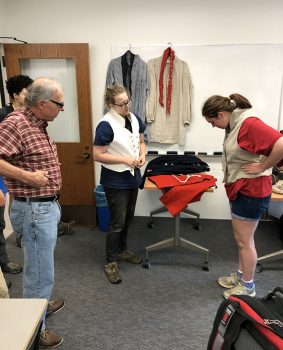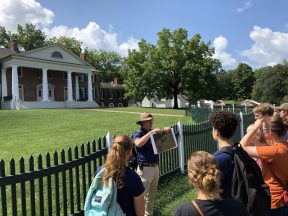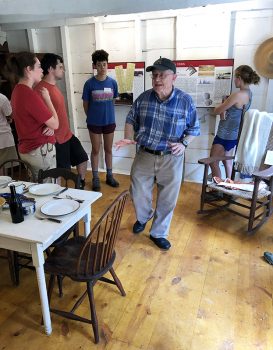Back to Dispatches from Field School
Field School 2018 – Week 9 (Part 1)
Patrick Hodge — St. Mary’s College of Maryland
“The Power of Archaeology”

Washington College Professor of Anthropology Charles Fithian sharing reproduction 19th-century naval costumes with field school students Moira Sullivan (right) and Olivia Redmond
The second-to-last week of field school flooded us with information that opened our eyes to the histories that are often omitted from the record. We started the week off with a lecture about the HMS De Braak, an 18-gun Royal Navy warship that capsized off Delaware during the French Revolutionary Wars. The De Braak was a brig-sloop which were built in huge numbers during this period, yet the information regarding these smaller ships is scant. The archaeology done on the preserved wreckage site provides evidence that women were on board and might have helped sail. The information about these lesser known yet more numerous members of the British navy was impactful, and shows there should be more work like it.

Montpelier Director of Archaeology Matthew Reeves (HSMC Field School Class of ’88) describing 19th-century changes to the Montpelier landscape
The next day we took a trip to Montpelier, where James Madison resided before and after his stint as the fourth President. Beyond the original mansion house, the entire property was expertly reconstructed to show life on a plantation. Not only did it show the elegant and rich lives of one of the most powerful colonial families in the country, but the humanity of the enslaved people who made that elegance and power possible. One of the most impactful pieces of information was the discovery of a plate that depicted a scene of 19th-century Polish insurrection. This artifact provided by archaeology shows that enslaved Africans purchased objects that they wanted and that they chose objects that spoke to their condition of enslavement and desire for freedom. This is not the only evidence of this practice.
To round out this week we took a tour of our very own Historic St. Mary’s City, which brought us to the still-standing slave quarters occupied by the enslaved Africans working for the Brome family. Inside one of the Brome quarters archaeologists discovered a Mexican ‘real’ coin bearing the image of a liberty cap and a hole poked through it. Strung coins were an African tradition to protect the wearer from spirits. It was truly incredible to learn about these people as they were, doing things they wanted to do, buying things they wanted to buy, and learning that through archaeology you can still learn a lot about people who history paid little attention to.


